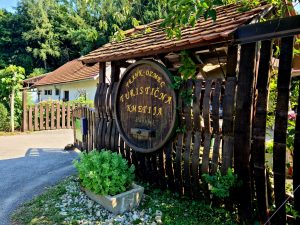Week 26. Half-way through the year. It’s hotter than Hades here in Budapest and I’m finding very little to be grateful for this week. The blasted heat. Yes, I know Ireland is cold and wet but what I wouldn’t swap for some of that coldness and wetness. Forty-two degrees yesterday. It is any wonder that I’m slowly losing my will to live.
I was in Szombathely last weekend and who did I run into but the bould Mr Joyce. I’d heard tell that there was a town/city in Budapest that translated into ‘bloom’ and was home to some severe Joycean celebrations each June. But, not for the first time, I got the story a little addled and it turns out that it was Leopold Bloom’s fictional father (him being fictional himself) that supposedly hailed from Hungary – Szombathely – and it’s his name – Virag that translates into flower or bloom. In his novel, Ulysses, Joyce gives Leopold Bloom’s ancestry as Bloom, only born male transubstantial heir of Rudolf Virag (subsequently Rudolph Bloom) of Szombathely . . .
Bridget Hourican writes in the Irish Times that:
Virag means flower in Hungarian, hence Bloom, but it’s a conceit of Joyce’s that Leopold’s father began life as Rudolf Virag. There were Jews in Szombathely called Blum, but never Virag. Laszlo Najmanyi, writer, musician and organiser of the Hungarian Bloomsday, says: “The Blums were big textile traders in Szombathely and members of the family were posted in Trieste. It’s likely that Joyce met them there.” Trieste was part of the Austro-Hungarian empire and Joyce certainly met Hungarians, including Teodoro Mayer, owner of Irredentist newspapers, and one of the models for Bloom. A motif in Ulysses is Arthur Griffith’s Resurrection of Hungary – the history of the struggle for independence from Austria, presented as a model for the Irish. The United Irishman serialised the book from January to June 1904, so of course characters in Ulysses are busy reading it.
Someone took the time to trace the Blum’s old house and erect a plaque over the door that further confuses the Blum/Virág/Bloom issue. I have to keep reminding myself that Leopold Bloom was a figment of Joyce’s imagination and neither he, nor his creator, is likely to be turning in his grave at the apparent inconsistencies. I have no one with whom to share my pain.
This week, as the barometers soar and the heat makes irrationality normal, I am grateful for being Irish. I am grateful that our reach is broad and our influence wide. I am grateful that we have left, and continue to leave, our mark on the world. As the lovely Colin Farrell supposedly said: Being Irish is very much a part of who I am. I take it everywhere with me.
PS – a nice gesture from the Mayor of Poznan after the Irish fans’ performance during Euro2012.
Share this:
- Click to share on X (Opens in new window) X
- Click to share on Facebook (Opens in new window) Facebook
- Click to share on Pinterest (Opens in new window) Pinterest
- Click to share on LinkedIn (Opens in new window) LinkedIn
- Click to share on Reddit (Opens in new window) Reddit
- Click to share on WhatsApp (Opens in new window) WhatsApp
- Click to share on Pocket (Opens in new window) Pocket
- Click to share on Telegram (Opens in new window) Telegram
- Click to email a link to a friend (Opens in new window) Email










5 responses
Interesting! Presumably the text in the centre of the plaque ‘Passing from land to land’ is from Joyce (I’ve got Ulysses somewhere, but haven’t the time to find it – especially if it isn’t there), in which case the Hungarian translation (‘Világokból . . .’) outdoes him a little: ‘Harried from society to society, among peoples, in the maelstroms of history.’